Dynamic floor pricing increases publisher revenue — with the right method and technology
Dynamic floor pricing is the biggest opportunity right now for publishers to maximize yield from programmatic advertising in the open exchange. But some publishers are skeptical regarding the effectiveness of this strategy, with concerns raised about whether dynamic floor pricing truly increases revenue or simply redistributes it.
In this article, we’ll explain the concepts underlying dynamic floor pricing (also called dynamic flooring), discuss the challenges facing publishers in implementing a flooring strategy, and present the ideal solution that has proven to drive significant revenue growth.
Does dynamic floor pricing work? The answer is yes, with an essential caveat — you must adopt the right method alongside technology that supports effective results.
What is flooring in digital advertising?
Flooring, or setting a price floor, is the process whereby publishers set a minimum CPM (cost per 1,000 ad impressions) they will accept from advertisers that wish to purchase ad space on their digital property.
Advertisers that programmatically bid for ad space will naturally try to secure the lowest possible price, but setting a floor means you are establishing a minimum price point for your ad inventory that you want the open exchange to respect.
Balancing CPMs and fill rate
With a CPM floor in place, your ad space will not sell for less than your minimum price — though this may mean that ad spaces go unfilled. You can set a $10 CPM floor, but if no advertiser is willing to pay that price, you’ll serve no ads and make no money at all.
On the other hand, if you set your floor too low, you may not be putting any pricing pressure on advertisers and miss out on earning more for your inventory.
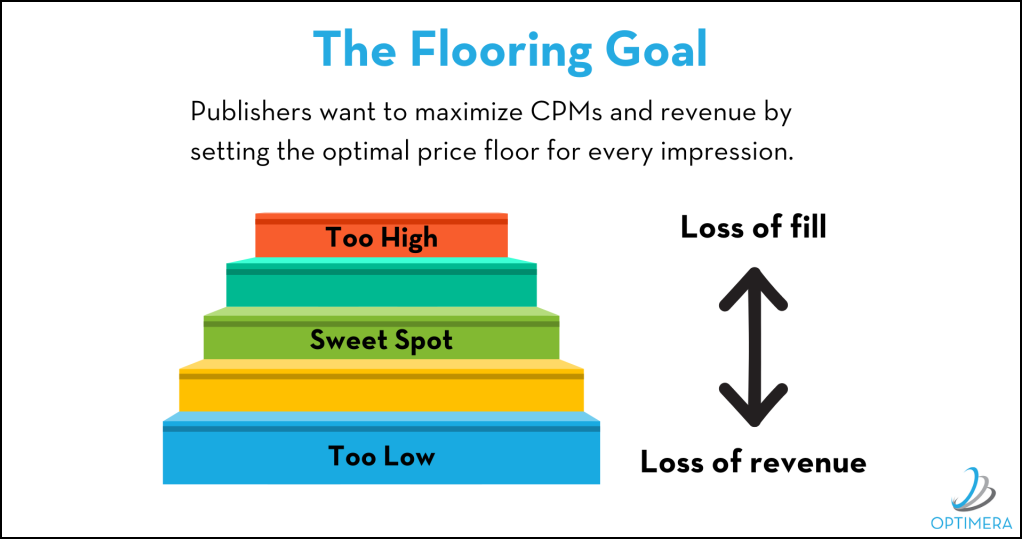
The challenge for publishers is to find the CPM sweet spot that achieves the highest ad fill rate at the highest price. But not only is this sweet spot hard to find — it’s constantly changing.
A single, static price floor will never be effective
There are many factors and data points that influence CPMs. One pageview may monetize completely differently from another pageview due to the page content, user demographics, traffic source, device type, browser, bid history, and so on.
For example, we see that home pages tend to monetize low. News content generally monetizes low, often due to brand safety challenges, while entertainment and sports usually monetize really high. So, you’ll need a floor for your low-monetizing inventory and a floor for your high-value inventory, based on content.
But, you also have traffic coming to your content from different sources. We know that traffic coming from social media tends to monetize lower than organic search traffic, so now we need floors for different traffic sources.
Then, you’re going to have different audience profiles for the users coming from these different traffic sources. Users will monetize differently based on their country, age group, and on and on, so there are more floors you’ll have to create.
Manual flooring is high effort, low success
Google introduced Unified Pricing Rules (UPRs) in Google Ad Manager (GAM) as a way for publishers to manually set price floors, and most other supply-side platforms (SSPs) have similar functionality.
With UPRs, you have the ability to set a variety of price floors (though you are limited to a finite number). But, you can’t set them and forget them, because CPMs are constantly fluctuating.
Seasonal trends affect CPMs, with buyer behavior varying based on time of year, time of quarter, and time of month. Macroeconomic factors and supply chain conditions influence CPMs as well. Your own ebb and flow of direct sold campaigns affects your optimal price floors, based on how much inventory you have to sell on the open exchange at any given time.
So, even if you’ve set a number of granular floors in GAM, you have to continually update them. UPRs set in November when direct deals are plentiful and competition is high will be much too high for the CPMs advertisers will be bidding come January. Likewise, if you set your floors in January, they’ll be much too low to be effective later in the year.
Even if you set floors at the beginning of each month, buying behavior will look completely different by the end of the month, so your floors will quickly become out of date.
For UPRs to be effective, you’d have to be constantly monitoring and updating them — a tremendous effort. We’ve seen that publishers who try to make this effort still only pull reports and make updates maybe once a month.
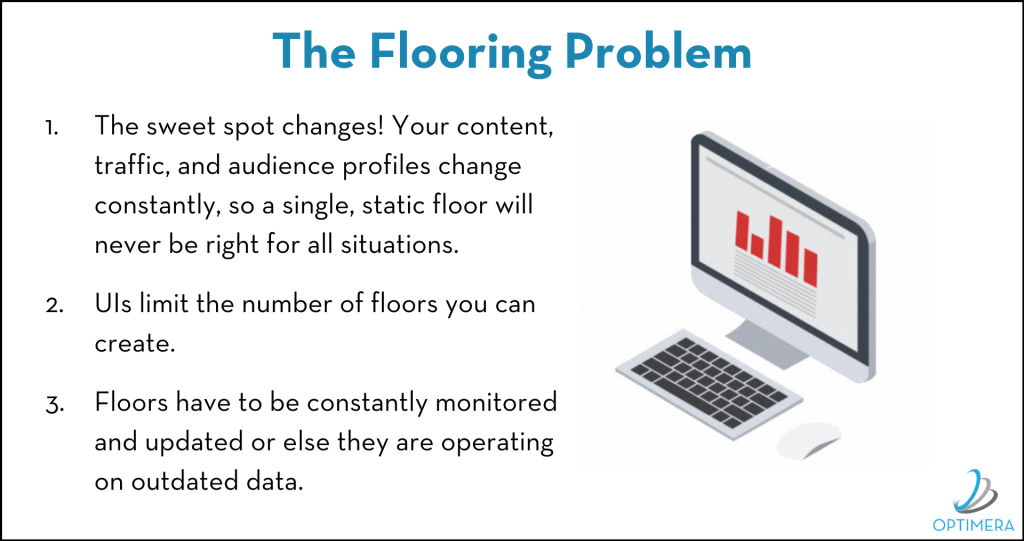
To be truly successful in creating revenue lift from the open exchange, your flooring solution must be granular. It must be automated. And it must be dynamic.
Dynamic Flooring — a blast from the past?
If the term “dynamic flooring” rings a bell, it may be because dynamic flooring had a brief period of popularity back when second-price auctions were in play. Several dynamic flooring vendors had some success in helping publishers lift revenue, but once the industry moved on from the second price auction model around 2017, their dynamic flooring technology no longer worked.
Since the switch to a first-price auction model, no one has cracked the code to a modern dynamic flooring solution — until Optimera.
We’ve worked closely with a few of our publisher partners to create a flooring strategy that is granular, automatic, and dynamic. And it works.
Auto-tuning UPRs isn’t a viable flooring solution
In the past year or so, we’ve seen new vendors pop up, claiming to increase revenue with dynamic flooring solutions. Their general approach is to use automated methods to update UPRs on some kind of regular cadence, aggregating data and using market rate averages to determine a price floor. Their flooring technique is basically being an AI UPR-tuning bot. This doesn’t work.
Dynamic price floor optimization that relies on industry averages or outdated data will never produce effective results. A price floor generated based on an average CPM simply cuts out all bids below the average price and adds no pricing pressure to the bids above the average.
And, to account for all the CPM-affecting factors and generate the right price for every granular situation, you’d need thousands of UPRs — which GAM isn’t equipped to support.
As we’ve discussed, the ideal price floor is constantly changing and requires a real-time, granular solution.
What is the ideal flooring solution?
The ideal flooring solution acts like this:
- Pass granular floors based on page content, user demographics, traffic source, device, browser, page historical CPMs, etc.
- Offer an infinite number of floors
- Dynamically adjust floors based on the latest, most accurate data
- Automate flooring optimization
- Set the right floor every time, for the ideal combination of highest fill and highest CPMs
And we have good news because this is effectively how Optimera’s Dynamic Flooring works.
Our flooring solution is a code-on-page header bidding system that integrates with GAM, measures advertiser outcomes, and feeds real-time data that establishes the right floor, at the right time, every time.
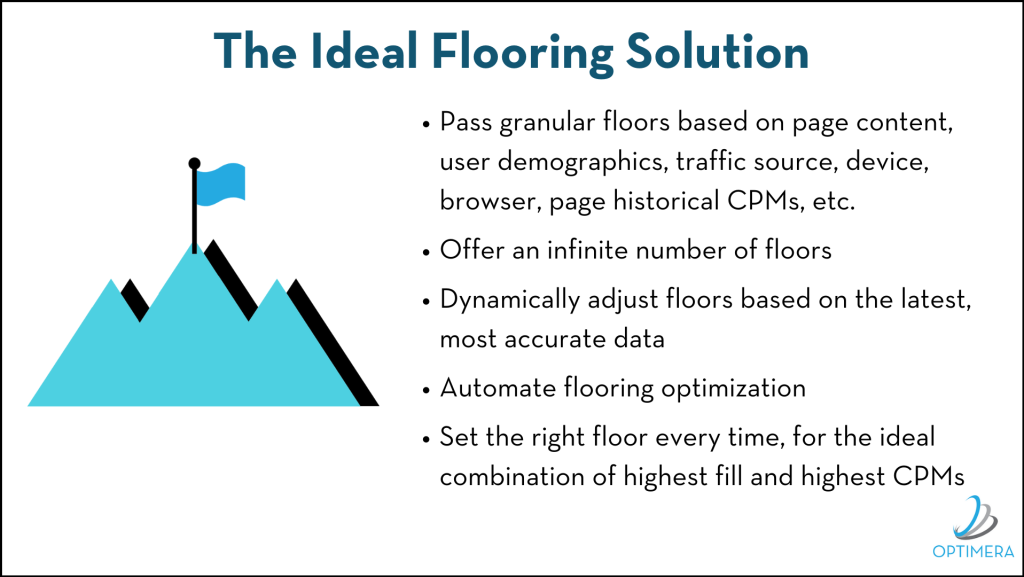
We’re not racing to create a trillion data points. Rather, we’re pinpointing which data points actually drive a valuation difference. For example, it doesn’t necessarily make sense to segment and set floors by day of the week, but it does make sense to set floors based on whether a specific user is on Safari or Chrome, because of the way the browsers handle user data and cookies and therefore affect the value of the user.
Additionally, you can create custom flooring segments based on your own first-party data — user logged in or not, subscriber vs non-subscriber, etc.
We build a map of all these crucial data points so that when the situation recurs, we know the ideal CPM floor — and the system updates that map continuously, every few minutes.
Optimera’s Dynamic Flooring solution effectively offers a unique floor in real time for every pageview, on every single piece of content and ad position. And it’s the way we do this that makes our solution more effective than anything else available on the market.
Dynamic floor pricing is all about affecting the SSP win rate
In our journey to create an effective dynamic flooring solution, we learned that the key is in affecting the win rate of SSP demand partners. When we introduce a floor, we want to measure if we are making the SSPs win less. And in winning less, they’ll bid higher.
SSPs, and by extension DSPs, adjust their bids based on their win rate. They want to win a certain percentage of the time — let’s say 20% — while getting the lowest price. So, if an SSP bids $2.00 and wins, their next bid will be $1.99. If they win at $1.99, they’ll try $1.98, and so on until they lose.
If they start to lose at $1.50, then they’ll up their bid to $1.51. In this scenario, this SSP will learn to achieve their target win rate of 20% by bidding around $1.50.
Optimera’s Dynamic Flooring puts pricing pressure on your ad revenue stack by becoming a bidding partner and attempting to win the bid a certain percentage of the time. This makes the SSPs bid higher to achieve their target win rate.
But just as there is a floor, there is a ceiling too. SSPs will reach a point where they are no longer willing to pay more for an ad impression, and at that point, Optimera reduces the pressure until the SSP starts bidding again, and in this way, Dynamic Flooring finds the ideal highest bid ranges for each SSP while simultaneously maximizing fill.
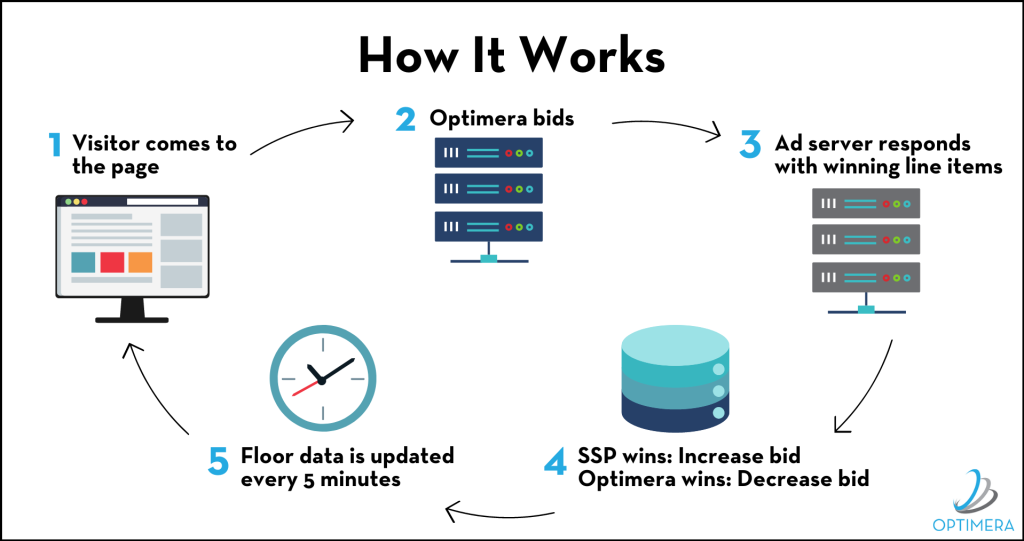
And we do this at the granular level of each of these data points we’ve mentioned, creating CPM increases among all these granular buckets. Added together, these CPM increases create meaningful revenue lift for publishers.
Optimera’s Dynamic Flooring is a proven solution that saves time and increases publisher revenue
Our floor pricing strategy takes all granular data points into account and operates without the use of UPRs. In fact, you can turn off your UPRs completely and stop worrying about monitoring or updating your price floors. Whether you’ve been dedicating hours, days, or entire team members to keeping floors updated, you’ll get all that time and effort back.
Most importantly, our Dynamic Flooring solution proves its worth. We implement a constant control that calculates lift and measures success.
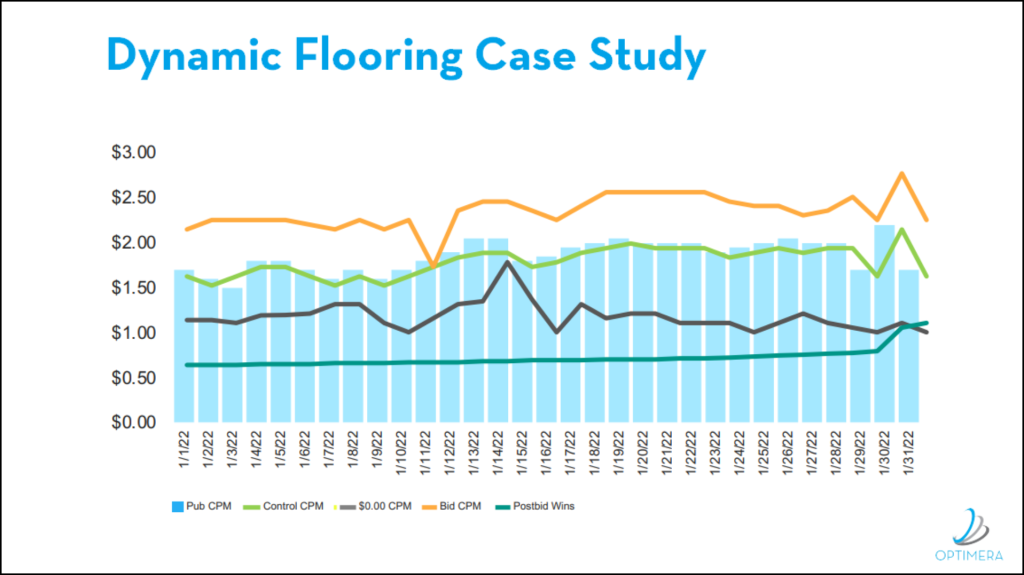
The graph above shows the publisher’s Control CPM hovering around the $1.50-$1.75 range, whereas the Bid CPM, which is what the publisher earned whenever Dynamic Flooring affected the bid, hovers around $2.25.
A common question we hear is, “What happens when Optimera wins the bid? Aren’t I losing money then?”
The answer is no! You can choose what serves when the Optimera line item wins, whether that’s a house ad or another demand partner via post-bid.
Flooring solutions that are simply auto-updating your UPRs can’t tell you why a given floor was passed at any specific point. Not only can we tell you exactly why a floor was set the way it was — since everything happens through GAM, you can pull your own reports and do your own data analysis to see trends and historical data.
Optimera Dynamic Flooring Case Study
Here’s an example of one publisher’s results after using Optimera’s Dynamic Flooring solution for eight months:
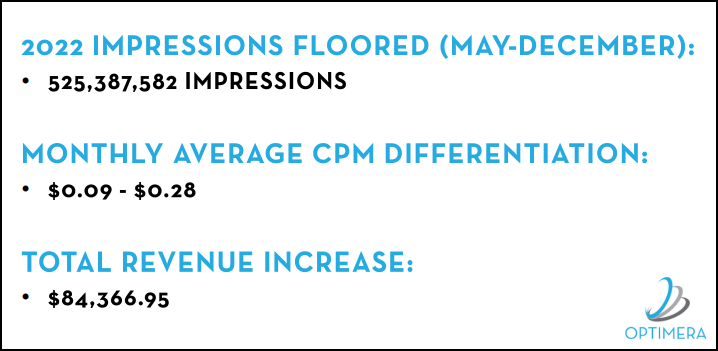
Dynamic Flooring impacted over half a million impressions, influencing a CPM increase between +$0.09 and +$0.28 each month, and resulting in a gross overall revenue increase of over $84,000.
This revenue increase doesn’t take into account any revenue earned when the Optimera line item won, so the net revenue lift was even higher. And, don’t forget to factor in the value of your team focusing those floor price setting hours on other projects.
Additional benefits of Optimera’s Dynamic Flooring
The news just keeps getting better. Not only does Dynamic Flooring save you a lot of time and make you money, there are additional benefits.
Sustainability has become a buzz word in the digital advertising industry lately as advertisers and publishers attempt to reduce their carbon footprint. One way publishers can make an effort toward this end is by reducing your number of network calls.
Optimera’s Dynamic Flooring aids this effort by pushing a floor into the bid request, which prevents SSPs from sending unnecessary bid responses that don’t meet the floor. So, publishers who are using Optimera to create dynamic floors can boast of being a little “greener.”
Also, Optimera illuminates non-monetizing, underperforming inventory, as the Optimera bidder will eventually reduce bids to $0.00 on this inventory since there is no SSP competition for it. This gives publishers the opportunity to review this inventory for any issues (such as brand safety violations or invalid traffic) and make adjustments to the content or monetize the articles in a different way.
If you’re implementing any kind of flooring strategy right now, you believe there is value in doing so. But unless you’re passing floors at granular levels and constantly updating them for the latest data, your floors won’t be optimal.
Ready to see real results? Here’s the best news of all — Optimera offers a free trial so you can test out our Dynamic Flooring solution and see how it works for you. There’s no long-term commitment and all trial revenue gains are yours to keep.
Dynamic Flooring is just one solution among our full publisher technology platform that works across all of your revenue streams to increase revenue and improve advertiser outcomes.
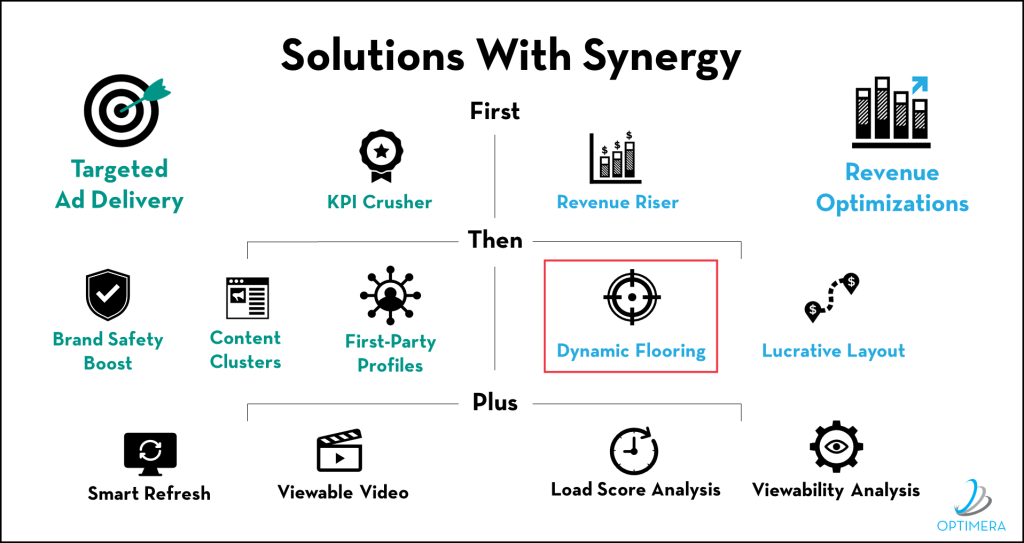
We’d love to add you to our growing network of high-quality publishers who, with the help of Optimera, are on the cutting edge of technology and innovation. Fill out the form below to let us know you’re interested, and we’ll be in touch!
